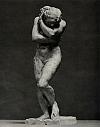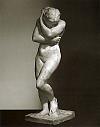 
A research programme based on empirical methods (1)
|

Spreckels Eve
Click to enlarge
|

MacLaren Eve
Click to enlarge
|
A simple question, raised by a newspaper journalist, stands at
the beginning of our research programme. When a museum object has the exact look
and the feel of an original art work, what does it matter than, if it was
handcrafted by the artist or created later, by means of some kind of replication
process? Before we can even start to discuss the philosophical implications, we now ask ourselves, what means do we have at all to judge
the similarity and difference between two objects, that at first glance look
identical?
|
Traditionally, measured dimensions, text descriptions,
provenance papers and photographs have been used to identify sculptural objects
and compare them to each other.
The authenticity of the Thinker foundry plaster now owned by the Sayegh Gallery,
Paris, for example, was formally confirmed after comparing two sets of photographs.
Since the lighting angle and perspective of two photos rarely is
identical and quality of images greatly varies, this method leaves room for
minor errors. It may be exactly such details, though, that might help us to determine
if two plasters actually come from the same mould or from the same workshop, or
if their relationship is more remote. And since sometimes there exist several
examples of a Rodin creation that all are officially accepted as
"original", an exact morphological comparison may reveal us that
generally accepted reference objects, used to judge the authenticity of other copies by, are
not identical in shape themselves.
|